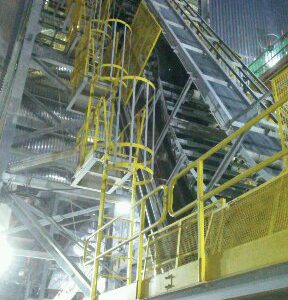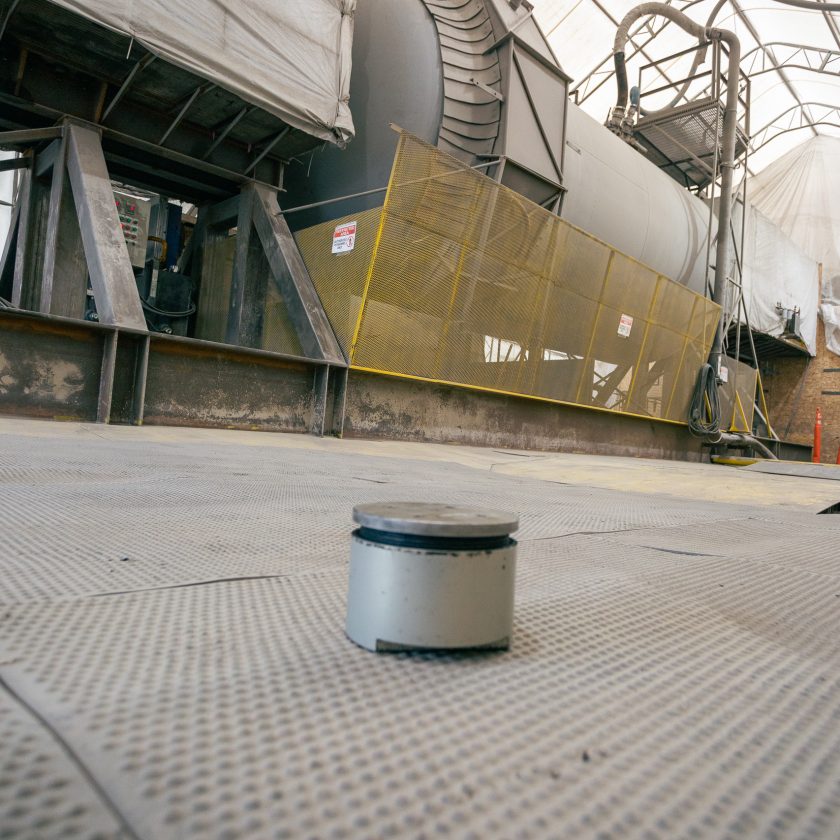Cement Plants Fed by Sandwich Belt High-Angle Conveyors Can Save You Some Bread.
By Mark S. Kuhar
 |
| Sandwich belt high-angle conveyors are proven, versatile systems for elevating or lowering bulk materials continuously at steep angles up to 90 degrees. |
Sandwich belt high-angle conveyors are proven, versatile systems for elevating or lowering bulk materials continuously at steep angles up to 90 degrees. A wide range of industries have adopted the system, to handle coal, refuse, coarse copper ore, hot clinker, municipal sludge, wood chips, gypsum, slag, excavated earth, various grains and more at throughput rates of 0.27 – 4,000 tph over elevating heights from 3.66 to 175 m.
The suitability of the sandwich belt high-angle conveyor for continuously elevating raw feed to cement plants has been well established by many installations over the years, even replacing other methods of high-angle conveying.
Installations at Cement Plants
The first example of a sandwich belt high-angle conveyor delivering raw products for cement manufacture was in an underground gypsum mine. The vertical system continuously elevated gypsum rock.
The underground crusher reduced the size of the material to a conveyable size (-6) and dropped it onto a reciprocating plate feeder to load the sandwich belt conveyor. At the surface, the conveyor discharged onto a plant conveyor that delivered the rock either to an outside storage pile or directly to the plant.
This completely vertical system replaced a horizontal feed conveyor and bucket elevator, considerably simplifying material transport and eliminating a high maintenance transfer point.
Closer to the cement-manufacturing process, the sandwich belt high-angle conveyor supplied to Steel Cement Co. in Australia’s Port of Melbourne, formed part of a complex, automated cement manufacturing plant.
The raw products, steel mill slag and gypsum were brought in by ship and stored in an open stock piles. The slag, a by-product of the steel-making process was shipped in from Japan.
As required, these were then delivered to separate holding bins, from which the sandwich high-angle conveyor was fed at different load points. The critical blending process was achieved by metered feeding of the products on to the sandwich conveyor’s lower in-feed belt then elevated and discharged directly into the grinding mill, where it was reduced to a fine particle cement. No firing was required because the steel mill slag is a clinker.
An additional installation for a cement plant in the southeastern United States delivered various raw products to the storage bunkers that ultimately fed the kiln.
A most interesting aspect of this installation was the long approach with multiple feed points. The blending of the products (limestone, gypsum, sand, iron ore, etc.) was achieved by a crane-mounted clamshell which stocks the materials above the respective apron feeders.
This 90-degree angle arrangement also replaced a previous system composed of a horizontal feed conveyor and bucket elevator, thus, once again, eliminating a transfer point and greatly reducing operating and maintenance costs.
The sandwich belt high-angle conveyor has also been used for the hot handling operations of a cement plant. Such a system replaced the typical arrangement of a long approach conveyor, linked to an elevating pan conveyor, and handled a range of materials from hot and powdery clinker to gritty pozzolanic sand to sharp lumpy gypsum rock. This was not only more economical but provided a system where material flowed continuously, with no intermediate transfer, until discharge.
Continuing to prove the versatility of the sandwich belt high angle conveyor, Dos Santos International commissioned a DSI Sandwich belt high angle conveyor with Zanella Engenhaira e Industria de Maquinas of Curitiba, Parana, Brazil. The project is part of a cement factory in the municipality of Pitimbu.
The factory arrangement was laid out to accommodate protected areas, reduce]ing the environmental impact. This request for a small footprint was easily achieved by the DSI Snake at Paraiba, elevating 720 tph of limestone, iron ore, sand and clay at a 60-degree incline.
Advancing the Technology for the Environment
 |
| The DSI Wet Brush applies a minimal amount of moisture to mitigate side migration of the bulk material towards the edge of the belt sandwich. |
Brennand recognized the challenge of the raw materials they were transporting and were seeking a better handling of raw materials. This DSI Snake was the first to utilize a commercially designed DSI Wet Brush, a system that applies a minimal amount of moisture to mitigate side migration of the bulk material towards the edge of the belt sandwich.Most bulk materials don’t need help from a Wet Brush, but some materials do have a tendency to migrate towards the belt’s edges.
The DSI Wet Brush utilizes precise water flow control and measurement that reacts to precise monitoring of the bulk material flow rate. A sonic, broad level sensor at the bulk material feed point along with a belt speed monitor provide all of the information required to control the wet brush system.
System interlocking maintains a perfectly dry system when there is no bulk material or the feed belt speed is zero. Material flow is measured continuously, and the wet brush automatically adjusts moisture for optimal response.
The DSI Snake at Paraiba features an extended loading zone that is fed by five separate belt feeders and chutes. It includes a cross-belt magnet to remove any tramp iron and a material analyzer that ensures the correct raw mixture. Eventually, in production, the plant will have a capacity of 3,000 tpd of clinker and 1.5 million tpy of cement.
The sandwich belt high angle conveyor technology has been used in a wide range of industries to convey many different materials. The applications described here show the suitability of these systems for carrying the array of bulk materials that are the raw feed for cement manufacturer.
Dos Santos International is pleased to continue the development of high angle conveyors that are a part of environmentally conscious projects that offer smaller physical and carbon footprints. DSI Sandwich conveyors offer a competent and reliable continuous elevating system for widely varying bulk materials such as those that are the raw feed to cement plants.
Information for this article courtesy of Dos Santos International, www.dossantosintl.com.




